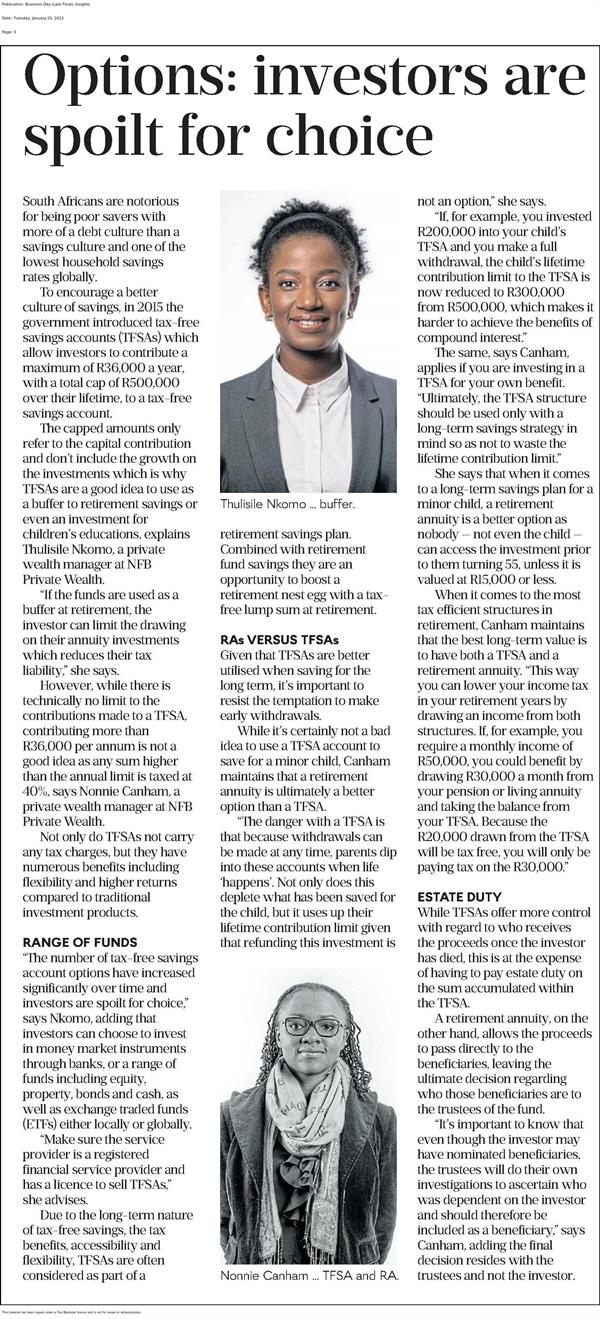Tax free savings accounts vs retirement annuities?
The reality is that the two are different savings vehicles with different tax treatments so it’s important to understand how they compare.


A frequently asked question is whether it’s better to invest in a tax free investment or a retirement annuity.
The reality is that the two is are different savings vehicles with different tax treatments so it’s important to understand how they compare.
Tax free savings accounts (TFSAs) are a relatively new option which were introduced in 2015 to encourage a better culture of savings. They allow investors to invest a maximum contribution of R36 000 a year, with a total cap of R500 000 over their lifetime, into a TFSA.
The benefit of a TFSA is that it does not incur any tax charges on either withdrawals or income drawn. These types of account have other benefits including higher returns compared to traditional investment products.
The cap refers only to the capital contribution and not the growth on the investment which is why a TFSA is a good idea to use as a buffer to retirement savings, given that the investor can limit the drawing on their annuity investments – which in turn reduces their tax liability.
Although it is technically possible, it’s not a good idea to invest more than the annual contribution to a TFSA because the additional investment will be taxed at 40%.
Since their introduction, the number of tax free saving account alternatives have grown with options including money market instruments available through commercial banks, or local or global funds focused on either equity, property, bonds, cash or even exchange traded funds. It’s a good idea to choose a reputable investment service provider that is a registered financial services provider and a license to sell TFSAs.
The biggest risk with TFSAs is their accessibility. Investors can withdraw funds from a TFSA at any time – but the catch is that they cannot refund the account at a later stage for that withdrawal as that would exceed the lifetime cap of R500 000. That means that withdrawing funds early defeats the purpose of the account and makes it harder to achieve the benefits of compound interest.
As a practical example, consider an investment of R300 000 into a TFSA. If after five years the investor makes a full withdrawal, they will have reduced their lifetime contribution limit to only R200 000. That leaves only R200 000 available to achieve the benefits of compound interest.
TFSAs are therefore better suited for long term savings so as to not waste the lifetime contribution limit.
Upon the death of the investor, the TFSA becomes part of the estate with the proceeds passed on to beneficiaries nominated in his or her will. However, while the TFSA offers more control with regards to who receives the proceeds, this is at the expense of having to pay estate duty on the sum accumulated within the TFSA.
Unlike a TFSA, there is no limit on contributions with a retirement annuity. However, once contributions exceed the deductible limit of either 27.5% of total taxable income – or R350 000 per annum – there ceases to be a tax benefit. That doesn’t mean that is no long term benefit in saving as much as you can for retirement. If you have available funds, it’s a good idea to contribute more. Similarly, when you receive your refund from SARS it’s in your best interests to plough that refund back into your retirement annuity and add to the compound growth of the annuity over the years.
A retirement annuity is not as accessible as a TFSA and cannot be accessed prior to the age of 55, unless the investor becomes disabled or emigrates.
Another difference is that only the first R500 000 withdrawal is tax free. The balance of withdrawals from a retirement annuity are taxed between 18% and 35%. Similarly, income drawn from a retirement annuity is taxed at the personal marginal rate as per the income tax tables.
On the investor’s death a retirement annuity does not form part of his or her estate. While it does allow the proceeds to pass directly to beneficiaries, it leaves the ultimate decision regarding who those beneficiaries are to the trustees of the fund. The trustees make that decision having taken into consideration the investor’s chosen beneficiaries and after doing their own investigations to ascertain who was dependant on the investor and should therefore be included as a beneficiary.
Ultimately, the best long term value is to have both a TFSA and a retirement annuity. This allows you to lower the tax payable in your retirement years by drawing an income from both structures.
If, for example, you need a monthly income of R50 000, you can draw R30 000 a month from your retirement annuity converted into a pension or living annuity and take the balance from your TFSA. As the R20 000 drawn from the TFSA is tax-free, you will only pay tax on the R30 000.
It’s always a good idea to get professional advice on how to formulate an investment strategy designed for your personal circumstances.
As Private Wealth Managers, we’re here to help you make better choices for your ultimate objectives - whether for current needs, retirement or legacy purposes - to build and preserve your wealth. Contact us today
| A version of the article was published in The Business Day. Read the original coverage here: | |
 |













